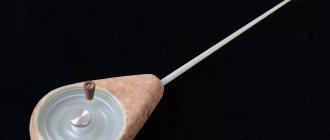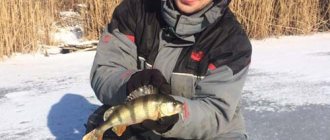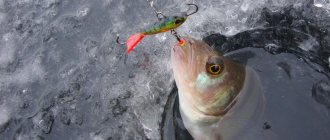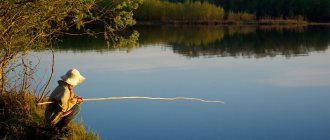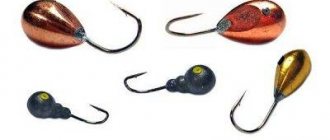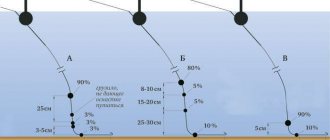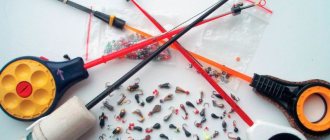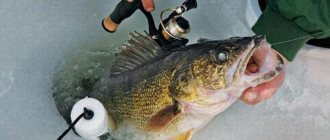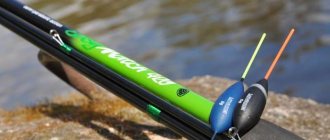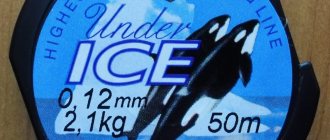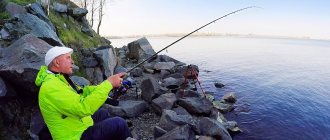What kind of fish to catch
In winter they catch:
- bream;
- crucian carp;
- carp;
- ram;
- roach.
Not only peaceful fish bite on bottom rigs, there are also predators:
- perch;
- pike;
- zander.
But this happens rather by chance, because predators prefer to hunt in the water column rather than near the bottom.
Features of winter donka
Winter donk fishing is done from ice in a hole, and long casts are not needed. The tackle is thrown into the same place, and the feeding is accurate. Advantages of winter donka:
- you don’t need to watch the fishing rod all the time;
- Fishing in strong currents is possible;
- a large area is fished;
- the nozzle is located next to the bait;
- Convenient supply of bait and bait.
In cold water, you should not feed the fish abundantly; the metabolism is slowed down, and it does not show activity in search of food. But with the help of a bottom rig, the bait is fed next to the hook, and the likelihood of a bite increases.
Groundbait and lures
Particular attention should be paid to complementary feeding. It is better to use special feeders for this, placing them much higher upstream, which gradually washes away the complementary food.
As bait, one of the preferred options is the following:
- 2 parts roasted sunflower seeds, minced through a meat grinder
- 4 parts ground crackers
- 1 part dried and ground citrus zest.
In strong currents, the composition of this bait can be made heavier by adding boiled millet.
You can also use a mixture of crackers with small food bloodworms and various store-bought options for special baits.
If we talk about baits, then all those used for fishing in still water are used:
- Bloodworm
- Maggot
- Dough
- Semolina
At times all of these baits work well in combination.
Winter donka - design features
Structurally, the winter donka consists of:
- fishing rod;
- a nod that registers bites;
- spools of fishing line;
- rigging.
In some varieties of winter fishing, fishing rods or reels are not used, but they can provide ease of use of the gear. The fishing rod is taken from a standard winter fishing rod, and the nods are used:
- lavsan;
- plastic;
- metal.
The nod is chosen to be flexible and sensitive to the slightest touch of the fish on the bait. Winter donka is a delicate tackle, so it can be used to successfully catch low-active fish. The optimal diameter of the main line for winter bottom tackle for peaceful fish is 0.16−0.20 mm, the diameter of the leader line is 0.1−0.14 mm.
When catching a predator, a base with a diameter of 0.2-0.25 mm is taken, leashes are knitted from monofilament fishing line 0.14-0.18 mm. Braided fishing line is rarely used in winter; in cold weather it becomes covered with ice and becomes heavier, creating inconvenience for the fisherman.
Separately, it should be said about the hooks, which should be made of thin wire and very sharp. Hook sizes 12−18 according to European classification, color:
- matte black;
- golden;
- red;
- blue.
It has been noted that blue and red hooks attract the attention of bream, crucian carp in winter are more willing to bite on golden hooks, and matte black is considered a universal color.
Important! Hooks need to be changed after every 2-3 fish caught.
Installation of gear
It should be emphasized that when fishing in the current, winter donks have clear advantages over rigs for vertical fishing. Thanks to the use of main weights of 5-50 g, the equipment is not carried away by the current from the fishing spot and does not lift from the bottom.
Hooks with a nozzle are always in the bottom layer, and when the bottom bites, self-hatching occurs. If the angler sees a bite, then to be sure he hooks the fish. But even if the attention of a winter fishing enthusiast is distracted and he does not have time to hook, the fish is caught on its own under the weight of the main sinker.
Winter donka tackle for bream or crucian carp consists of:
- a piece of monofilament fishing line 1.5−2 m long with a diameter of 0.18−0.22 mm;
- 3-4 leashes with hooks on a monofilament line with a diameter of 0.10-0.16 mm;
- main cargo weighing 5−50 grams;
- float stops;
- additional weight 5−10 g.
When making a winter donka “helicopter”, used for catching bream in strong currents, a “rail”, a small box without end walls, is also mounted on the tackle.
Due to the absence of walls and installation with a parachute, the box vibrates in the current, creating an attractive visual picture, and provokes the fish to bite. Instead of a box, oval pieces of tin or plastic are used, but the principle of fastening and operation of the donkey remains the same.
Float rod
A winter float rod is the most common tackle for catching bream from ice. Its popularity is due to its high efficiency and ease of installation. It includes the following elements:
• fishing rod “filly”; • monofilament line 0.15 mm thick; • float with a carrying capacity of about 2 g; • set of loads; • hook No. 16–10.
For an under-ice float, a fishing rod called a “filly” is perfect. In comparison with other designs, it has a number of undeniable advantages:
• low price; • ease of use in cold weather; • increased reliability.
Expert opinion
Smirnov Alexander Stanislavovich
Wilderness survival instructor. More than 15 years of teaching experience
In addition, the “filly” has minimal weight, which allows you to take a large number of different rigs with you when fishing. The float rig does not use leashes, which significantly increases its strength characteristics.
During the fishing process, the piece of fishing line between the hook and the sinker always lies on the bottom, so the large diameter of the monofilament does not alarm the fish. The float should be made of rigid foam and have a minimum number of additional parts.
Such products are very strong, durable and easy to clean from ice. This element is attached to the fishing line using a silicone cambric.
Particular attention should be paid to loading the bite alarm. When fishing, the bulk of the pellets should be a meter from the bottom.
A small weight is installed 5 cm from the hook, which completely drowns the float. When fishing for bloodworms, use a No. 16 hook made of thin wire.
This is interesting: Rules of behavior in the forest consultation (senior group)
For fishing with worms and maggots, you need to take larger models.
How to assemble it yourself
Winter donks are sold in stores, but if you assemble them yourself, it is both more economical and easier for the fisherman to understand the design and make it at his own discretion.
High-quality winter bottom tackle should be:
- unnoticeable;
- reliable;
- functional.
For peaceful fish
The tackle is mounted on the main line or on a piece of monofilament line in the following order:
- a stopper is placed on the base and moved up 1.5 meters;
- then the main load of 20-50 grams is put on;
- further, another stopper fixes the load, and it moves a meter up the line;
- a leash is knitted 20 cm below the stopper;
- Another leash is tied even lower 20 cm;
- then the stopper is put on;
- then a small load;
- The swivel is tied last;
- Another leash is tied to the swivel.
The result is a rig with sliding weights that press it to the bottom, but do not create resistance when the fish bites. Hooks for winter donkeys with a sliding load are taken from numbers 12–16 according to the European classification. It is better if the hooks are red; they provide camouflage and blend in with the bait, which is:
- bloodworm;
- purulent worm;
- red maggot.
When using other baits, the hooks are black or golden. To ensure maximum camouflage of the winter bottom rig, it is tied on a piece of fluorocarbon or fluorocarbon fishing line. Such materials are absolutely transparent and invisible in water. Large fish are especially careful, they are scared away by ordinary fishing line, and the use of fluorocarbon significantly increases the catchability of the gear.
The rig, tied on a separate piece of fishing line, is tied to the base using the loop-to-loop method before fishing, and after fishing is finished it is removed and wound onto a reel. It is convenient to store such installations in thick plastic bags with a zip fastener. Before packing the tackle in a bag, you should dry it thoroughly so that the fishing line does not rot and the hooks do not rust.
On a predator
The predatory fish also catches the donk, intended for its peaceful counterparts, because it also loves to feast on bloodworms or worms. Special donks for predators are different in that they are designed for fishing with live bait. The equipment should hold the live fish in a position that is attractive to pike or perch.
A heavy sinker can cope with such a task, and thanks to the long leash, the live bait moves freely in the water column and does not look like bait at all.
To confidently hold live bait and reliably catch a predator, tee hooks are used on a leash made of fluorocarbon fishing line 0.3 mm and 50-70 cm long.
A winter donka for a predator is mounted on the main fishing line. A sliding weight is placed at the end of the base, and a swivel is placed below it, thus ensuring free sliding of the weight along the fishing line. A leash with a tee is tied 20-30 cm above the load, onto which live bait is put. After the bottom is lowered into the hole, the live bait goes into free swimming, and the fish bite is registered using a flexible whip or bell attached to the fishing line.
The base is on the reel, and even if a predator makes a rapid jerk, the line comes off the spool freely until the angler is hooked.
Attention! Small crucian carp is the best live bait, even on a tee it can attract attention
The nuances of fishing in different bodies of water
Fishing on different types of reservoirs has its differences. So, fishing on a pond or lake is different from fishing on a river. Features of winter fishing should be taken into account when selecting equipment and bait
and so on.
On the lake
How to find a suitable fishing spot on an unfamiliar lake depends on a number of factors:
- The fisherman must know the size and depth of the reservoir where the fish will be caught, and understand what kind of fish he expects to catch.
- He should acquire the necessary equipment for catching fish.
First, anomalies in the bottom topography are identified. This can be done by measuring the depth in the holes at a short distance from each other. Characteristic signs of such anomalies are cracks, holes and grass. When a place is found, you need to make sure that there are fish there. Algorithm of actions:
- A quick way is to go around the holes with search gear. Judging by the result, you can decide on the fishing method and select the necessary gear. The place where the fish bite more often needs to be fished. You can continue searching in other places if the fish are not biting in the place you find. It is recommended to use bait to get the best results.
- If there is enough time to search, then you should find suitable holes and feed them until the fish appear. This must be done only in those holes where the fish are already biting, otherwise you can use up all the bait and waste time without getting a bite. Thus, there is a possibility of finding and concentrating inactive or distant fish around this hole.
Walking fishing is a tactic in which the fisherman walks around all the holes with gear. At the same time, he fishes a large area of the reservoir without staying long on 1 hole. Time is spent drilling a hole and testing for catch.
The advantage of this method is that the angler has a high chance of finding active fish in the place where you least expect it. You can find places where fish feed in a small area.
The disadvantages of this method include the fact that if the fish do not gather in schools or are inactive, then the gear for searching and checking the hole will not force it to bite.
This tactic is most effective in shallow water and for finding active fish.
On the river
The chances of catching large fish (pike perch, bream, roach, silver bream) in the current are greater than in still water. There are no fish weighing less than 100 g in fast currents.
Fishing on the river has its own difficulties, which must be fully foreseen; the secrets of fishing with fast currents and great depths are as follows:
- The length of the fishing line should be much greater than the depth of the river.
- The line under the hole will not go straight, but will take an arched shape. The vibrations produced by the hand will not reach the bait, so you should not use fishing skills in still water.
Fish that feed need to be given the bait closely. She will bite the bait if you give the latter the necessary movements. For this purpose, it is necessary to evaluate the strength, speed and direction of the current in order to predict what movements the bait will make.
Under such conditions, it is difficult to give natural movements to the bait. To do this, you should know the features of the gear and have experience.
For bloodworms, maggots or larvae, the natural movement will be a smooth descent towards the bottom with a slight shift towards the current. To enhance the effect, you should take short pauses between movements of the bait.
This is interesting: Fish day: what you need to consider when going winter fishing
What bait to use
When fishing from ice, when winter bottom gear is used, the choice of bait is limited only by the angler’s imagination. The predator bites not only on live bait, but also on:
- spinners;
- silicone baits;
- wobblers.
All baits used for catching predators in open water also work in winter when fishing from holes. When catching peaceful fish on the current, the winter bottom is equipped with animal baits rich in protein. They are most attractive to bream, crucian carp or roach.
Which month is the best
Bream begins to feed only 2 weeks after the establishment of ice cover. In central Russia, this period usually falls in the first half of December.
Active biting continues until mid-January. In the second half of January, the fish becomes extremely passive and reluctantly reacts to bait offered to it.
The bite can resume during long thaws, when fresh water begins to flow under the ice.
This is interesting: 4 real stories about people who survived on a desert island
In February the picture does not change. In the second half of March, it leaves its winter resting places, forms large flocks and begins to move around the water area. During this period, it is well caught using various types of reelless jigs. The key to successful fishing on the last ice is an active search, which involves drilling a large number of holes.
Winter donka fishing technique
When catching peaceful fish or predators with the winter bottom, no clever fishing is used; the tackle is lowered into the hole, and the fishing rod is placed on a stand, waiting for a bite. After the bite and successful hooking, the angler needs to carefully bring the fish to the hole and get it out using a hook.
When catching a predator, be more careful and have a supply of base on the reel, because both pike and pike perch are actively moving, and the supply of fishing line should be enough to hook and fish them out.
Donka fishing is one of the most exciting types of winter fishing, and fishermen use this equipment regardless of the conditions of the reservoir or weather. A properly mounted winter donka will give you many worthy trophies.
Fishing tactics
Winter donka is somewhat different from summer donka. If in the summer it’s enough to just throw the tackle and sit waiting for bites, then in the winter the process looks a little different.
After lowering the weight to the bottom, you need to rewind another half meter of fishing line. As a result, the current will pull the line a little, and we will get an arc at the bottom.
The top leader will be very close to the bottom. After this, you need to play with the bait a little, but so that the sinker lies motionless.
It is very difficult to explain how to do this. Skill comes only with experience.
Expert opinion
Smirnov Alexander Stanislavovich
Wilderness survival instructor. More than 15 years of teaching experience
In some cases, just a slight movement of the bait is enough, followed by a bite. Sometimes a bite follows immediately after placing the fishing rod on the stand.
When fishing with a bottom, it is important to find a point with fish. For this it is better to use an echo sounder. After the fish is found, you need to give it bait. An excellent bait for catching roach like this:
We start feeding with cone feeders, put bloodworms on the hooks, and actively catch roach and bream.
A complete review of winter fishing gear and accessories can be found here:
Read about autumn, summer and spring fishing gear here
.
Good fishing online stores
will allow you to purchase any fishing goods at competitive prices!
Follow us on social networks
– through them we publish a lot of interesting information, photos and videos.
The fisherman's calendar will allow you to understand how all the fish bite depending on the time of year and month.
The fishing gear page will tell you about many popular gear and devices for fishing.
This is interesting: Spinning trout fishing on paid lakes
Fishing baits – we describe in detail live, plant, artificial and unusual ones.
In the bait article you will get acquainted with the main types, as well as tactics for using them.
Learn all the fishing lures to become a real fisherman and learn how to choose the right one.
Most anglers associate bottom tackle with fishing in open water, but it is also successfully used in winter, when bodies of water are covered with ice. Winter donka is especially popular in those regions with a harsh climate and short summers.
In the last 5-7 years, many fans of winter bottom fishing have appeared and have already achieved decent results.
